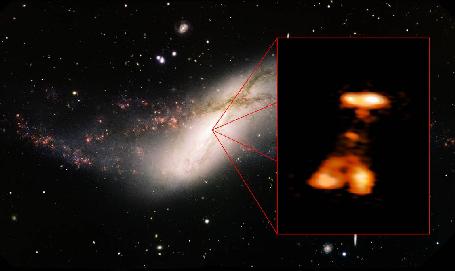EMBARGOED For Release: 9:00 a.m., PST, Monday, January 7, 2013
Contact:
Dave Finley, Public Information Officer
Socorro, NM
(575) 835-7302
dfinley@nrao.edu
Massive Outburst in Neighbor Galaxy Surprises Astronomers
The surprising discovery of a massive outburst in a neighboring galaxy is giving astronomers a tantalizing look at what likely is a powerful belch by a gorging black hole at the galaxy's center. The scientists were conducting a long-term study of molecules in galaxies, when one of the galaxies showed a dramatic change.
"The discovery was entirely serendipitous. Our observations were spread over a few years, and when we looked at them, we found that one galaxy had changed over that time from being placid and quiescent, to undergoing a hugely energetic outburst at the end," said Robert Minchin, of Arecibo Observatory, who presented the research.
The scientists were using the National Science Foundation's (NSF) 305-meter William E. Gordon Telescope at Arecibo for their study when they discovered the outburst in NGC 660, a spiral galaxy 44 million light-years distant in the constellation Pisces. The outburst was ten times brighter than the largest supernova, or exploding star. They reported their findings at the American Astronomical Society's meeting in Long Beach, California.
After detecting the outburst, the team continued to observe NGC 660 with the Arecibo Telescope, and also sought to determine the cause of the outburst using an international network of telescopes to make a detailed image of the galaxy.
"High-resolution imaging is the key to understanding what's going on," said Emmanuel Momjian, of the National Radio Astronomy Observatory (NRAO). "We needed to know if the outburst came from a supernova in this galaxy or from the galaxy's core. We could only do that by harnessing the high-resolution imaging power we get by joining widely-separated radio telescopes together."
The astronomers used a network called the High Sensitivity Array (HSA), composed of the NSF's Very Long Baseline Array (VLBA), a continent-wide system of ten radio telescopes ranging from Hawaii to the Virgin islands; the Arecibo Telescope; the NSF's 100-meter Green Bank Telescope in West Virginia; and the 100-meter Effelsberg Radio Telescope of the Max Planck Institute for Radio Astronomy in Germany.
"By adding the large collecting area of the three big dishes to the VLBA, we got the images much more quickly. What we did with the HSA in less than half a day would have taken nearly nine days with the VLBA alone," Momjian said.
The resulting images were more complex than the scientists expected. They thought they would see either the ring of an expanding supernova or a jet of superfast material from the galaxy's core. Instead, they saw five sites of bright radio emission, one near the center of the galaxy and two on either side.
"The most likely explanation is that there are jets coming from the core, but they are precessing, or wobbling, and the hot spots we see are where the jets slammed into material near the galaxy's nucleus," said Chris Salter, of Areceibo Observatory. "To confirm this, we will continue to observe the galaxy with the HSA over the next few years," he added.
If the jet idea is correct, the outburst probably was caused by material pulled into the supermassive black hole at the center of the galaxy. The material would form a rapidly-spinning disk around the black hole before finally falling into it, and the disk would generate jets of particles blasting outward at nearly the speed of light.
Astronomers are carefully watching a gas cloud in our own Milky Way Galaxy that is expected to fall into our Galaxy's central black hole in the middle of this year.
The National Radio Astronomy Observatory is a facility of the National Science Foundation, operated under cooperative agreement by Associated Universities, Inc. The Arecibo Observatory is operated by SRI International under a cooperative agreement with the National Science Foundation (AST-1100968), and in alliance with Ana G. Mendez-Universidad Metropolitana, and the Universities Space Research Association.

